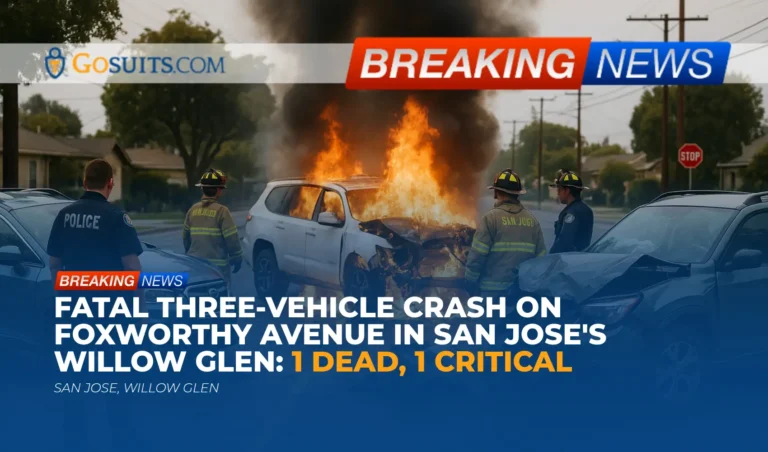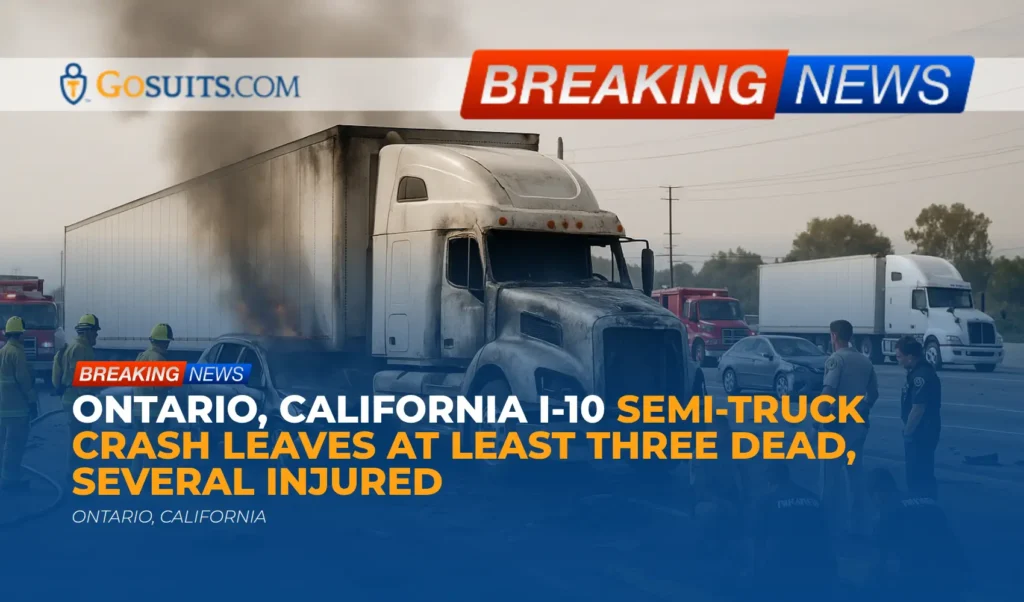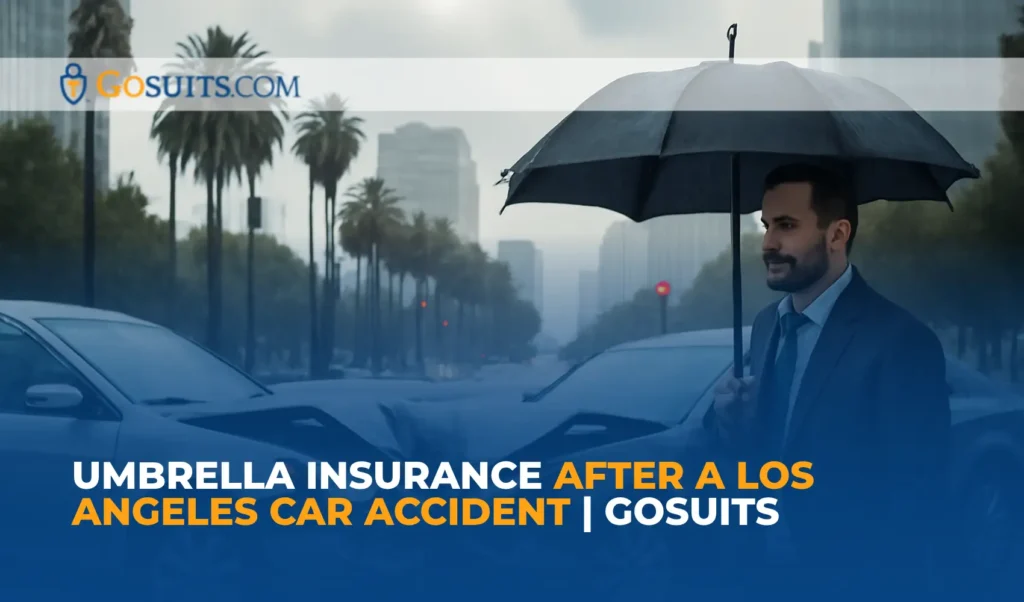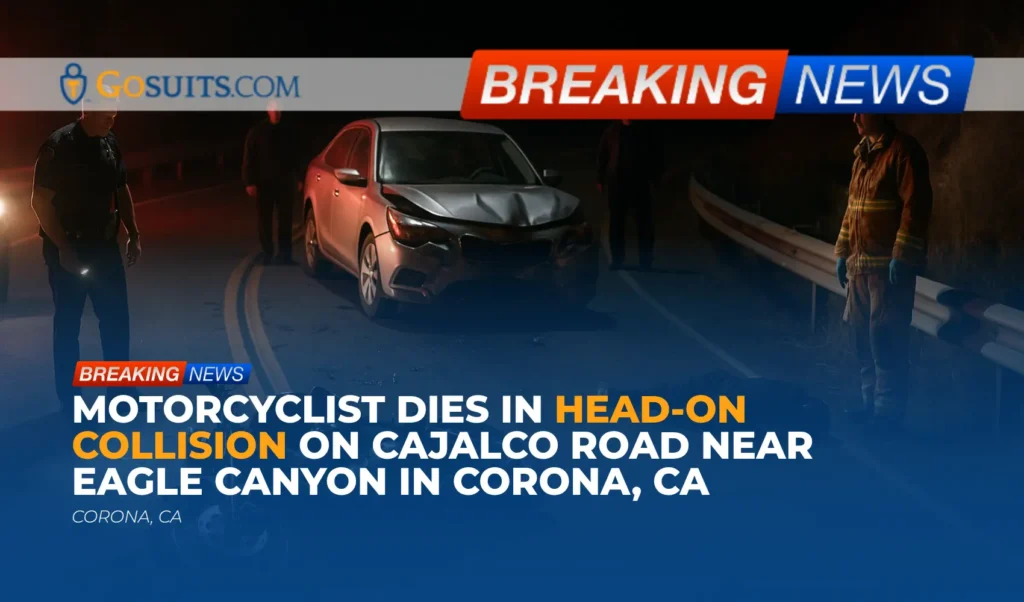- What Happened on Foxworthy Avenue in Willow Glen
- Law Enforcement Statements and Witness Accounts
- Location Context and Safety Concerns on Foxworthy Avenue
- Legal Overview for Families After a Fatal or Catastrophic Crash
- Key California Traffic Laws Implicated
- Practical Steps to Protect Rights and Evidence
- Where to Obtain Official Records and Information
- Safety and Policy Context About Speeding Risks
- How Witnesses Can Help Right Now
- Commentary from Gosuits San Jose, California Personal Injury Attorney
- Time-Sensitive Call-to-Action Guidance
- Government and Academic Sources Cited
What Happened on Foxworthy Avenue in Willow Glen
A three-vehicle collision in San Jose’s Willow Glen area resulted in one fatality and one critical injury, according to information provided by local authorities and reported publicly. The crash occurred around 2:35 p.m. on a Saturday along Foxworthy Avenue west of Jarvis Avenue, in the southern portion of Willow Glen north of Hillsdale Avenue. Foxworthy is a two-lane roadway divided by a double yellow line.
According to a San Jose Police Department summary disseminated afterward, a white 2018 GMC Denali SUV traveling east on Foxworthy attempted to pass a green 2018 Subaru Forester on the right as it neared Jarvis. During the maneuver, the GMC and Subaru made contact. The GMC then crossed into the opposite lane and struck a blue 2012 Honda CR-V head-on. The woman driving the Honda died at the scene. The male driver of the GMC sustained life-threatening injuries and was listed in critical condition. The Subaru’s driver, a woman, was not physically injured.
Surveillance video from the neighborhood captured the immediate aftermath, showing the SUV erupting in flames upon impact. A resident described the crash force as sounding like a bomb. Police indicated that firearms were found in one of the vehicles but noted they were unrelated to the collision. The identity of the deceased driver will be released by the Santa Clara County Office of the Medical Examiner after family notification. San Jose Police noted this was the city’s 31st fatal collision and 31st traffic death of 2025. Investigators asked anyone with additional information to contact Detective DelliCarpini #4103 at 4103@sanjoseca.gov or 408-277-4654.
The above details are limited to information shared publicly by police and media at the time of this writing. Any further conclusions will depend on the ongoing investigation and official reports.
Law Enforcement Statements and Witness Accounts
Police reports describe an attempted pass on the right by the GMC and a subsequent sequence leading to a head-on impact with the Honda. This sequence is consistent with a loss of control or lane encroachment following initial contact with the Subaru that was being overtaken. The police public statement did not confirm specific pre-crash speeds at this time, though a resident reported that an officer mentioned a high speed estimate and that witnesses described a prior dispute at a nearby store. Police did not confirm the witness accounts of any prior argument and stated that firearms found were unrelated to the collision event.
It is important to separate confirmed facts from unconfirmed witness statements. The official collision report and reconstruction analysis will be central to determining speed, lane positions, impact dynamics, and contributory factors. For families and involved parties, the law enforcement collision report, forensic evidence, and any event data recorder information may be critical in evaluating fault and liability.
Location Context and Safety Concerns on Foxworthy Avenue
Foxworthy Avenue in Willow Glen is a two-lane arterial with a double yellow centerline, connecting residential neighborhoods and local connectors. Residents in the area have reportedly raised concerns about speeding and impairment on this segment in recent years, requesting traffic calming measures such as speed humps. The specific statutory speed limit can vary by segment, but the witness account referenced a posted limit of 30 to 35 miles per hour. Regardless of the posted limit, California’s basic speed law requires drivers to travel at a speed that is reasonable and prudent for conditions, independent of the posted limit.
High-speed impacts on two-lane urban roadways can lead to severe injuries given the potential for head-on collisions and intrusion into the occupant compartment. Traffic enforcement, engineering improvements, and community reporting play intertwined roles in reducing risk. The City of San Jose’s Vision Zero program focuses on reducing traffic deaths and serious injuries and may consider crash patterns, speed profiles, and roadway design features when prioritizing safety improvements.
Legal Overview for Families After a Fatal or Catastrophic Crash
When a fatal crash occurs in California, two civil pathways are commonly discussed. First, a wrongful death claim may be brought by certain surviving family members. Second, a survival action may be pursued on behalf of the decedent’s estate for harms the decedent suffered prior to death. Each serves different purposes and involves distinct damages and procedural rules.
Wrongful death claims
California law allows specific relatives or dependents to bring a wrongful death claim for losses they suffer due to a loved one’s death. This generally includes economic losses such as the value of financial support, and noneconomic losses such as the loss of companionship and support. The statute that authorizes who may bring such a claim is in the California Code of Civil Procedure. The deadline to file is typically two years from the date of death under California’s statute of limitations for personal injury and wrongful death.
Survival actions
A survival action allows the decedent’s estate to recover for the decedent’s own losses that accrued before death, which may include medical expenses and, in some circumstances, certain categories of damages that the decedent could have claimed had they survived. Whether punitive damages may be available depends on the facts and comes from a separate statute that requires proof of conduct such as malice or a willful and conscious disregard of others’ safety. These are complex determinations tied to the specific evidence in a case.
Insurance considerations
Multiple insurance policies may potentially apply in a multi-vehicle crash, including the at-fault driver’s liability coverage, underinsured or uninsured motorist coverage, medical payments coverage, and, where applicable, additional coverages carried by passengers or households. The California Department of Insurance offers consumer guidance on auto claims, including claim timeframes and the claim process. Statements made to an insurer can affect fault determinations and claim outcomes. It is prudent to consult with a qualified attorney before giving recorded statements to an insurance adjuster, as what is said can be used later during claims processing or litigation.
Deadlines and claims against governments
In addition to the two-year limitations period that applies in many wrongful death and serious injury claims, an important shorter deadline may apply if claims are asserted against a public entity, such as for an alleged roadway defect or dangerous condition of public property. California’s Government Claims Act generally requires written notice to the public entity within six months. Evaluating whether public entity theories are viable requires timely investigation and expert analysis of roadway design, signage, sight distances, speed management tools, and prior crash history.
Nothing here is a guarantee of any outcome. The facts, insurance contracts, and governing law will determine the avenues available to each family.
Key California Traffic Laws Implicated
Basic speed law
California’s basic speed law requires that drivers never travel faster than is reasonable and prudent for conditions, considering weather, visibility, traffic, and road surface, even if the posted speed limit would otherwise permit a higher speed. Excessive speed increases stopping distance and crash severity, particularly on two-lane roads with oncoming traffic.
Passing on the right
California permits passing on the right only under limited circumstances and only when it can be done safely. Drivers may not pass on the right by driving off the paved roadway and must ensure the maneuver will not create an unsafe condition. Attempting this maneuver on a two-lane urban street often poses elevated risks, particularly where parked cars, driveways, intersections, or narrowing lanes are present.
Double yellow lines and lane discipline
Where a double yellow line is present, drivers are generally prohibited from crossing it except where permitted by law, such as for left turns or when a center two-way left-turn lane is present and properly used. Adhering to lane discipline is especially important on corridors with higher volumes and residential activity where unexpected lane changes can lead to head-on or sideswipe collisions.
The official California Vehicle Code provisions relevant to these topics include the basic speed law, rules on passing on the right, and lane line compliance. Links to the statutes are listed in the sources section below.
Practical Steps to Protect Rights and Evidence
Severe crashes produce a short window to secure evidence and protect civil claims. The following steps are general information for community members seeking to understand the process. Because every situation is different, it is wise to consult an attorney before engaging with opposing insurers or making recorded statements.
Preserve vehicles and onboard data
Modern vehicles may contain event data recorders that capture pre-crash speed, brake status, throttle position, and seatbelt use, among other parameters. This information can be critical for reconstruction. The National Highway Traffic Safety Administration maintains information about EDRs and their role in crash analysis. Securing and preserving a vehicle before it is repaired, salvaged, or released without documentation can be essential. Spoliation concerns often arise if vehicles are altered before data is retrieved by qualified professionals.
Collect and safeguard scene evidence
Where possible and safe, photographs and video of the scene, skid marks, debris fields, fluid trails, resting positions, and nearby cameras can be invaluable. For nearby businesses or residences with surveillance, prompt outreach is important because footage can be overwritten quickly. Eyewitness contact details, timestamped notes, and weather or lighting observations can strengthen the evidentiary record.

Medical documentation and follow-up
For survivors, thorough medical evaluation and consistent follow-up care are necessary both for health and for documenting injuries. Medical records, imaging, and provider notes help demonstrate causation and severity. Keep all bills, receipts, and mileage logs related to treatment. Families managing a fatality should request multiple certified copies of the death certificate for insurance, benefits, and estate matters.
Insurance communications
Insurance carriers often reach out quickly after serious crashes. Before giving a recorded statement or signing medical releases, consider consulting an attorney. Statements can be used to minimize or shift fault. The California Department of Insurance offers consumer guidance on auto claims, claim handling timelines, and complaint processes. Document all claim communications in writing and keep copies of correspondence.
Mandatory DMV accident report
California requires a Report of Traffic Accident Occurring in California, known as form SR-1, to be filed with the Department of Motor Vehicles within 10 days when a crash results in injury, death, or property damage above a statutory amount. Failure to file can lead to license consequences. The DMV’s SR-1 page explains who must file and how to submit the form. Consider consulting an attorney for guidance before communicating about fault or causation in any filings.
Where to Obtain Official Records and Information
San Jose Police Department collision information
For this crash, investigators asked anyone with information to contact the Traffic Investigations Unit, Detective DelliCarpini #4103, by email at 4103@sanjoseca.gov or by calling 408-277-4654. The San Jose Police Department’s main page provides information on units, public information channels, and general contact numbers. Collision reports are typically released to involved parties or next of kin when available and may require an online or in-person request pursuant to California law.
Link: San Jose Police Department
Santa Clara County Medical Examiner-Coroner
The Medical Examiner-Coroner will confirm identity and cause of death and is responsible for next-of-kin notification. Once permitted by law, the office may provide autopsy and investigative reports to authorized requesters. The county website explains request procedures, identification requirements, and any associated fees. Families often request multiple certified records for insurance and legal purposes.
Link: Santa Clara County Medical Examiner-Coroner
Death certificates from the Clerk-Recorder
Certified copies of death certificates are issued by the Santa Clara County Clerk-Recorder. The website explains eligibility, in-person and mail procedures, fees, and processing times. Having several certified copies can streamline life insurance claims, benefit applications, and estate administration.
Link: Santa Clara County Clerk-Recorder
City of San Jose public records
San Jose maintains an open government and public records portal where members of the public can request city records. For police records, the portal typically routes requests to the appropriate department. Processing times and exemptions are governed by California public records law.
Link: City of San Jose Open Government
Road safety concerns and Vision Zero
If residents are concerned about speeding, visibility, or recurring crash patterns on Foxworthy Avenue or nearby corridors, the City of San Jose Department of Transportation receives service requests and provides information on its Vision Zero safety strategy. Community reports can support data-driven prioritization of traffic calming, speed management, and enforcement.
Link: San Jose Department of Transportation
Insurance guidance from the State of California
The California Department of Insurance offers consumer guides on auto claims, what to expect from insurers, timelines, and how to file complaints if claim handling is unfair. These resources can help people understand their rights when dealing with insurance companies after a serious crash.
Link: California Department of Insurance Auto Insurance Resources
Safety and Policy Context About Speeding Risks
Speed is a leading factor in crash severity. The National Highway Traffic Safety Administration reports that speeding remains involved in a substantial share of traffic fatalities each year nationwide. Higher speed increases the energy involved in a collision, lengthens stopping distance, and reduces the time available for drivers to react to hazards. On two-lane urban streets with a double yellow line, any loss of control or lane departure at elevated speed can lead to head-on collisions with devastating consequences.
Passing on the right on urban two-lane roads is particularly hazardous due to driveways, parked cars, narrowing lanes near intersections, and limited sight lines. California law restricts passing on the right and requires that any such maneuver be done only where permitted and only when it can be completed safely without leaving the paved roadway. Combining an improper pass with speed multiplies risk factors.
Local enforcement and engineering measures can help reduce these risks. Speed feedback signs, speed humps where appropriate, narrowed travel lanes, high-visibility crosswalks, and targeted enforcement are examples of tools jurisdictions may apply based on crash histories and community input. San Jose’s Vision Zero approach prioritizes corridors with higher rates of severe and fatal crashes for safety improvements and enforcement. Residents who observe consistent speeding or near-misses can report locations to the city for review.
How Witnesses Can Help Right Now
Independent witnesses can be essential to a thorough and fair investigation. If someone witnessed the crash sequence or has dash camera or home surveillance footage from the time around 2:35 p.m. on the date of the collision near Foxworthy Avenue and Jarvis Avenue, sharing it with investigators can help establish lane positions, speeds, and the timing of events.
- Provide statements and footage. Contact the San Jose Police Traffic Investigations Unit and reference the collision on Foxworthy Avenue in Willow Glen. The contact provided by police is Detective DelliCarpini #4103 at 4103@sanjoseca.gov or 408-277-4654.
- Preserve original files. Save original video files with their metadata. Do not edit or compress the footage if possible. Back up copies on a separate device.
- Document timelines. Note the camera time settings and whether the device clock was accurate. Write down what you saw as soon as possible while details are fresh.
Contributing accurate information can support both the criminal and civil components of accountability, and can help families find answers about what happened.

Commentary from Gosuits San Jose, California Personal Injury Attorney
Our hearts are with everyone affected by the crash on Foxworthy Avenue, especially the family of the woman who lost her life and the community members who witnessed such a traumatic event. This article is offered for general information to help community members understand the process that follows a serious collision. It is not a substitute for personalized guidance.
Based on the information shared publicly, there are serious safety concerns implicated by an attempted pass on the right and indications of high speed on a two-lane roadway with a double yellow centerline. California’s traffic laws make clear that drivers must always operate at a speed that is reasonable and prudent for conditions, and that passing maneuvers must be legal and safe. In civil cases, those facts often carry significant weight in determining liability, though final conclusions depend on the full investigative record, including official reports, physical evidence, and any electronic data from the vehicles.
Insurance companies move quickly after serious crashes to protect their bottom line. Adjusters may seek recorded statements or medical authorizations early, sometimes before all injuries are understood or before families have had time to process what has happened. It is common for insurers to use statements or partial information to argue for shared fault, minimize damages, or steer claimants into early settlements that do not account for the full scope of losses. Corporations and carriers handle these issues every day, while families are navigating grief, medical care, or funeral arrangements. The imbalance of knowledge and experience can disadvantage those who are simply trying to do the right thing.
There is real value in obtaining a free consultation to understand rights, timelines, and evidence needs before engaging with insurers. Early advice can help avoid missteps, ensure key evidence is preserved, and clarify how wrongful death and survival claims work in California. An initial conversation can also help identify all potential insurance coverages and any time-sensitive notices that might apply, especially where a public entity may be implicated by roadway conditions.
Time-Sensitive Call-to-Action Guidance
- Secure official records early. Police collision reports, medical examiner findings, and death certificates form the backbone of any civil claim. Waiting can delay claim processing and can make it harder to reconstruct what happened.
- Preserve vehicles and data. Vehicles can be towed, repaired, or salvaged quickly. Event data recorder information and physical damage patterns are often decisive. Taking steps within days or weeks, not months, helps avoid permanent loss of key evidence.
- Manage insurance communications carefully. Recorded statements and broad medical authorizations can affect fault and damages. Timing and wording matter. Acting now to get knowledgeable guidance before engaging with insurers can prevent unintentional harm to a claim.
- Track time limits. California’s two-year statute generally applies to wrongful death and serious injury claims, and a six-month claim presentation deadline can apply to public-entity claims. Early evaluation ensures no deadlines are missed while evidence is assembled and responsible parties are identified.
- Organize documentation. Create a secure file for medical records, funeral expenses, wage information, and communications. Organized documentation accelerates claim evaluation and reduces stress later.
- Empower witnesses. Community members with video or firsthand observations should preserve and share information with investigators. Early witness outreach can capture details that fade over time.
Taking these steps promptly can protect the integrity of any future claims process and improve the chances that the full story of the crash is documented accurately.
Government and Academic Sources Cited
- California Vehicle Code section 22350, Basic Speed Law
- California Vehicle Code section 21754, When Passing on the Right is Permitted
- California Vehicle Code section 21755, Passing on the Right Safely
- California Vehicle Code section 21460, Double Lines
- California Code of Civil Procedure section 377.60, Wrongful Death
- California Code of Civil Procedure section 335.1, Two-Year Statute of Limitations
- California Government Code section 911.2, Government Claims Act Deadline
- California Civil Code section 3294, Punitive Damages Standard
- National Highway Traffic Safety Administration, Speeding Risks and Data
- National Highway Traffic Safety Administration, Event Data Recorders
- California DMV SR-1 Accident Reporting Requirements
- California Department of Insurance, Auto Insurance and Claims
- San Jose Police Department
- Santa Clara County Medical Examiner-Coroner
- Santa Clara County Clerk-Recorder
- San Jose Department of Transportation
- City of San Jose Open Government






